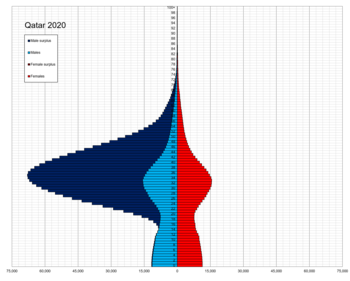
Back سكان قطر Arabic Население на Катар Bulgarian Demografía de Catar Spanish جمعیتشناسی قطر Persian Démographie du Qatar French דמוגרפיה של קטר HE कतर की जनसांख्यिकी Hindi კატარის დემოგრაფია Georgian 카타르의 인구 Korean Kataro demografija Lithuanian
| Demographics of Qatar | |
|---|---|
 Population pyramid of Qatar in 2022 | |
| Population | 2,937,800 (2022 est.) |
| Growth rate | 1.04% (2022 est.) |
| Birth rate | 9.33 births/1,000 population (2022 est.) |
| Death rate | 1.42 deaths/1,000 population (2022 est.) |
| Life expectancy | 79.81 years |
| • male | 77.7 years |
| • female | 81.96 years (2022 est.) |
| Fertility rate | 1.9 children born/woman (2022 est.) |
| Infant mortality rate | 6.62 deaths/1,000 live births |
| Net migration rate | 2.45 migrant(s)/1,000 population (2022 est.) |
| Age structure | |
| 0–14 years | 14.23% |
| 15–64 years | 84.61% |
| 65 and over | 1.16% |
| Sex ratio | |
| Total | 3.36 male(s)/female (2022 est.) |
| At birth | 1.02 male(s)/female |
| Under 15 | 1.02 male(s)/female |
| 65 and over | 1.13 male(s)/female |
| Nationality | |
| Nationality | Qatari |
| Language | |
| Official | Arabic |
Natives of the Arabian Peninsula, many Qataris (Arabic: قطريون) are descended from a number of migratory Arab tribes that came to Qatar in the 18th century from mainly the neighboring areas of Nejd and Al-Hasa. Some are descended from Omani tribes. Qatar has about 2.6 million inhabitants as of early 2017, the vast majority of whom (about 92%) live in Doha, the capital.[1] Foreign workers amount to around 88% of the population, the largest of which comprise South Asians, with those from India alone estimated to be around 700,000.[2] Egyptians and Filipinos are the largest non-South Asian migrant group in Qatar. The treatment of these foreign workers has been heavily criticized with conditions suggested to be modern slavery. However the International Labour Organization published report in November 2022 that contained multiple reforms by Qatar for its migrant workers. The reforms included the establishment of the minimum wage, wage protection regulations, improved access for workers to justice, etc. It included data from last 4 years of progress in workers conditions of Qatar. The report also revealed that the freedom to change jobs was initiated, implementation of Occupational safety and health & labor inspection, and also the required effort from the nation's side.[3]
Islam is the official religion, and Islamic jurisprudence is the basis of Qatar's legal system. A significant minority religion is Hindu due to the large amount of Qatar's migrant workers coming from India.
Arabic is the official language and English is the lingua franca of business. Hindi-Urdu and Malayalam are among the most widely spoken languages by the foreign workers.[4] Education in Qatar is compulsory and free for all citizens 6–16 years old. The country has an increasingly high literacy rate.
- ^ "Ministry of Development Planning and Statistics". Archived from the original on 26 June 2018. Retrieved 7 February 2017.
- ^ "Population of Qatar by nationality – 2017 report". Archived from the original on 22 November 2018. Retrieved 7 February 2017.
- ^ "Four years of labour reforms in Qatar". www.ilo.org. 1 November 2022. Retrieved 11 November 2022.
- ^ "Qatar Tourist Guide". Retrieved 15 February 2012.
© MMXXIII Rich X Search. We shall prevail. All rights reserved. Rich X Search